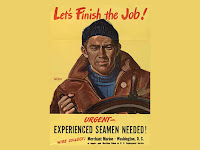“There is no doubt about it, the merchant seamen took it on the chin during the first half of this year —with no guns, no patrols, antiquated lifebelts, and practically no safety precautions. They were sent out as helpless targets for the subs; but their morale was as magnificent as it was unheralded. That precautions are now being taken to protect them doesn't detract from their courage….
“Those who have been torpedoed and rescued ship right
out again as soon as they can get out of the hospital. That takes plenty of nerve, but the merchant
seamen have it. They don't get much publicity, and you seldom hear anyone
making speeches about them. They don't get free passes to the theater or the
movies, and no one gives dances for them, with pretty young actresses and
debutantes to entertain them. No one ever thinks much about their
"morale" or how to keep it up.
It was only recently that a bill was passed to give them medals. And because they wear no uniforms they don't
even have the satisfaction of having people in the streets and subways look at
them with respect when they go by.”— American editor, writer
and socialite Helen Lawrenson (1907-1982), “ ‘Damn the Torpedoes!’”, originally
published in Harper’s Magazine, July 1942, reprinted in Reporting World War II: Part One: American Journalism, 1938-1944 (Library of
America anthology, 1994)
Perhaps because of husband Jack Lawrenson, the
charismatic co-founder and leader of the National Maritime Union, Helen
Lawrenson—previously known for her writing about New York society in the
1930s—wrote with marvelous empathy for the sacrifices and heroism of the
American merchant marine in WWII.
At the time Lawrenson reported on these sailors for Harper’s
in May 1942, U.S. merchant vessels had, through the first four months of
the year, endured more than 100 attacks by German U-boats off American coasts. Nearly
1,000 seamen were killed during this time. Even after precautions were finally
taken, an average of five or six of these boats were sunk in April alone.
The image accompanying this post—a recruitment poster
from 1944—illustrates these men’s grim determination in the face of all
hazards.
Much has been written over the years about the “The
Greatest Generation” who served in the armed forces during WWII, and I hope to
blog more about them myself in the future.
But the merchant seamen in the war faced their own
perils in hauling vital cargo in the conflict, and for years their bravery went
comparatively unrecognized (the likes of Lawrenson excepted).
Estimates for the number of these men who lost their
lives in the war ranged from 6,000 to 9,000, and the survivors of these attacks
would not soon forget the fire, explosions, runs for their lives, circling
sharks, and floating in open water after their boats were hit.
They couldn’t forget all that—and neither should we.
While Lawrenson’s article gives an excellent contemporary account of their
dangers and courage, William Geroux’s May 2016 piece for Smithsonian
Magazine offers a longer-term perspective on what we owe them.

No comments:
Post a Comment